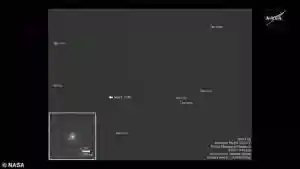NASA’s recent unveiling of new images of the mysterious interstellar visitor 3I/ATLAS didn’t go as planned.
The space agency hosted a press conference on YouTube to showcase the latest photos captured by probes, but instead of awe-inspiring shots, viewers were shown blurry, distant dots.
The reveal quickly drew skepticism, ridicule, and accusations of a cover-up from social media users.
A Comet, Not a UFO
According to NASA, 3I/ATLAS is simply a comet.
Associate Administrator Amit Kshatriya emphasized, “3I/ATLAS is a comet,” adding that no evidence of alien life or artificial structures had been detected.
The images were intended to show chemical emissions from the object rather than clear visuals of the object itself, but critics were unconvinced.
Social Media Erupts
The press event quickly became fodder for online debate.
Some users accused NASA of deliberately withholding detailed images. “What a waste of time! NASA is lying so bad.
The gaslighting is off the charts,” one person wrote on X. Another demanded, “Dump the entire unedited image archive to Wikileaks.”
Even the best image, captured by NASA’s HiRISE camera aboard the Mars Reconnaissance Orbiter, failed to impress.
Taken from just 19 million miles away, the photo appeared as a fuzzy, black-and-white smudge, showing no discernible shape of the object.
Anomalies Ignored?
Skeptics pointed to anomalies identified by Harvard professor Avi Loeb, including a comet tail pointing in the wrong direction, unexpected color changes near the Sun, and course shifts that don’t align with normal gravity patterns.
NASA’s team, however, dismissed these irregularities as natural consequences of 3I/ATLAS originating from a different solar system with a unique chemical composition.
Nicky Fox, associate administrator for NASA’s Science Mission Directorate, said, “We certainly haven’t seen any techosignatures or anything from it that would lead us to believe it was anything other than a comet.”
She added, “It’s gonna look different because it didn’t come from our solar system.”
Public Frustration and Humor
Despite NASA’s reassurances, many online remain unconvinced.
“Seems like they are trying really hard to convince us that it’s just a rock,” wrote one user.
Others approached the event with humor, joking about the poor image quality or the cautious phrasing of NASA officials.
When directly asked if the agency had considered the possibility of 3I/ATLAS being an alien craft, Fox avoided a definitive answer, remarking only, “We love all of the different science and all of the different hypotheses into what these things can be.”
Scientific Consensus
Since its discovery in July, the majority of astronomers and scientists have aligned with NASA’s assessment: 3I/ATLAS is a comet, albeit one with a slightly different chemical makeup than typical objects from our solar system.
While speculation about alien technology remains lively online, the scientific community continues to treat the visitor as a natural phenomenon.
Share on Facebook «||» Share on Twitter «||» Share on Reddit «||» Share on LinkedIn